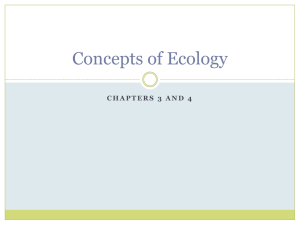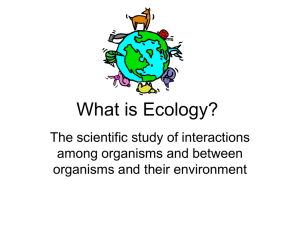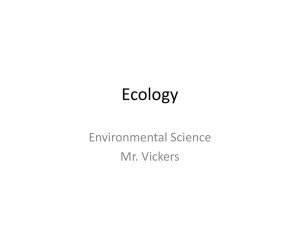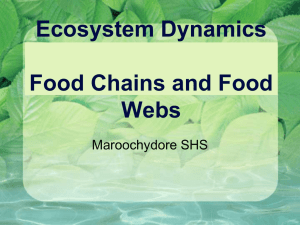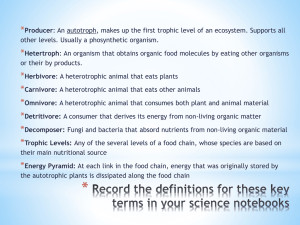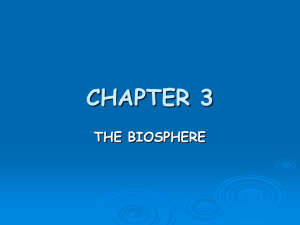The branch of biology dealing with interactions among organisms
advertisement
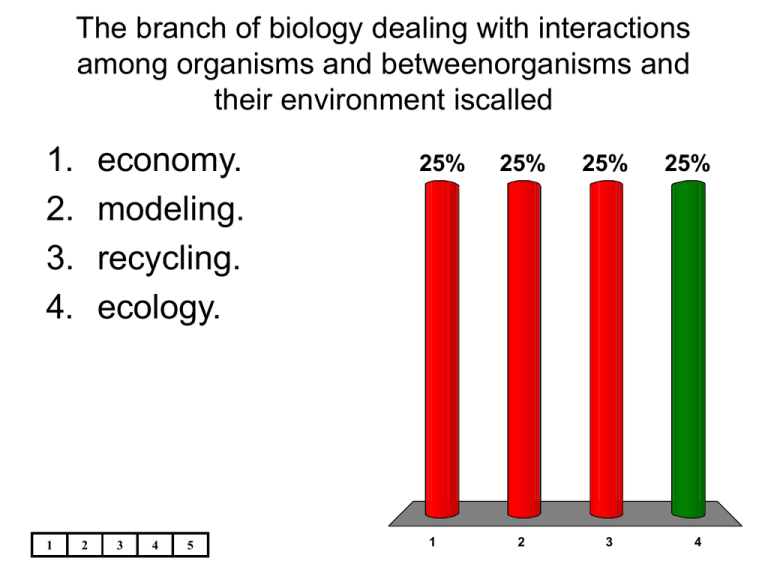
The branch of biology dealing with interactions among organisms and betweenorganisms and their environment iscalled 1. 2. 3. 4. 1 economy. modeling. recycling. ecology. 2 3 4 5 25% 1 25% 25% 2 3 25% 4 The combined portions of Earth in which all living things exist is called the 1. 2. 3. 4. 1 biome. community. ecosystem. biosphere. 2 3 4 5 25% 1 25% 25% 2 3 25% 4 All of the members of a particular species that live in one area are called a(an) 1. 2. 3. 4. 1 biome. population. community. ecosystem. 2 3 4 5 25% 1 25% 25% 2 3 25% 4 Which of the following descriptions about the organization of an ecosystem is correct? 1. Communities make up species, which make up populations. 2. Populations make up species, which make up communities. 3. Species make up communities, which make up populations. 4. Species make up populations, which make up communities. 1 2 3 4 5 25% 1 25% 25% 2 3 25% 4 The simplest grouping of more than one kind of organism in the biosphere is 1. 2. 3. 4. 1 a population. a community. an ecosystem. a species. 2 3 4 5 25% 1 25% 25% 2 3 25% 4 The lowest level of environmental complexity that includes living and nonliving factors is the 25% 25% 25% 25% 1. biome. 2. community. 3. ecosystem. 4. biosphere. 1 2 3 4 5 1 2 3 4 Which of the following is NOT a basic method used by ecologists to study the living world? 25% 25% 25% 25% experimenting classifying modeling observing 1. 2. 3. 4. 1 2 3 4 5 1 2 3 4 Which ecological inquiry method is an ecologist using when he or she enters an area periodically to count the population numbers of a certain species? 1. 2. 3. 4. 1 questioning observing experimenting modeling 2 3 4 5 25% 1 25% 25% 2 3 25% 4 A mathematical formula designed to predict population fluctuations in a community could be called a(an) 25% 25% 25% 25% 1. biological experiment. 2. biological system. 3. ecological model. 4. ecological observation. 1 2 3 4 5 1 2 3 4 Plants are 1. 2. 3. 4. 1 producers. consumers. herbivores. omnivores. 2 3 4 5 25% 1 25% 25% 2 3 25% 4 What is the original source of almost all the energy in most ecosystems? 1. 2. 3. 4. 1 carbohydrates sunlight water carbon 2 3 4 5 25% 1 25% 25% 2 3 25% 4 Figure 3–1 The algae at the beginning of the food chain in Figure 3–1 are 1. 2. 3. 4. 1 consumers. decomposers. producers. heterotrophs. 2 3 4 5 25% 1 25% 25% 2 3 25% 4 An organism that uses energy to produce its own food supply from inorganic compounds is called a(an) 25% 25% 25% 25% 1. heterotroph. 2. consumer. 3. detritivore. 4. autotroph. 1 2 3 4 5 1 2 3 4 Which of the following organisms does NOTrequire sunlight to live? 1. chemosynthetic bacteria 2. algae 3. trees 4. photosynthetic bacteria 1 2 3 4 5 25% 1 25% 25% 2 3 25% 4 An organism that cannot make its own food is called a(an) 1. 2. 3. 4. 1 heterotroph. chemotroph. autotroph. producer. 2 3 4 5 25% 1 25% 25% 2 3 25% 4 In which way are plants in a sunny mountain meadow and sulfur bacteria in a deep-sea volcanic vent alike? 1. They both use photosynthesis to make their own food. 2. They both produce carbohydrates and oxygen. 3. They both use chemosynthesis to produce their own food. 4. They both produce carbon and hydrogen. 1 2 3 4 5 25% 1 25% 25% 2 3 25% 4 Organisms that obtain nutrients by breaking down dead and decaying plants and animals are called 25% 25% 25% 25% 1. decomposers. 2. omnivores. 3. autotrophs. 4. producers. 1 2 3 4 5 1 2 3 4 What is an organism that feeds only on plants called? 1. 2. 3. 4. 1 carnivore herbivore omnivore detritivore 2 3 4 5 25% 1 25% 25% 2 3 25% 4 All the interconnected feeding relationships in an ecosystem make up a food 1. 2. 3. 4. 1 interaction. chain. network. web. 2 3 4 5 25% 1 25% 25% 2 3 25% 4 The total amount of living tissue within a given trophic level is called the 1. 2. 3. 4. 1 organic mass. trophic mass. energy mass. biomass. 2 3 4 5 25% 1 25% 25% 2 3 25% 4 What is an ecological model of the relationships that form a network of complex interactions among organisms in a community from producers to decomposers? 25% 1. 2. 3. 4. 1 25% 25% 2 3 25% food web an ecosystem food chain a population 2 3 4 5 1 4 What animals eat both producers and consumers? 1. 2. 3. 4. 1 herbivores omnivores chemotrophs autotrophs 2 3 4 5 25% 1 25% 25% 2 3 25% 4 What is the term for each step in the transfer of energy and matter within a food web? 1. 2. 3. 4. 1 energy path food chain trophic level food pyramid 2 3 4 5 25% 1 25% 25% 2 3 25% 4 A bird stalks, kills, and then eats an insect. Based on its behavior, which ecological terms describe the bird? 25% 25% 25% 2 3 25% 1. herbivore, decomposer 2. producer, heterotroph 3. carnivore, consumer 4. autotroph, herbivore 1 2 3 4 5 1 4 A snake that eats a frog that has eaten an insect that fed on a plant is a 1. first-level producer. 2. first-level consumer. 3. second-level producer. 4. third-level consumer. 1 2 3 4 5 25% 1 25% 25% 2 3 25% 4 Figure 3–2 The trophic levels in Figure 3–2 illustrate 1. the relative amount of energy at each level. the amount of living organic matter at each level. the relative number of individual organisms at each level. that the producers outnumber firstlevel consumers. 2. 3. 4. 1 2 3 4 5 25% 1 25% 25% 2 3 25% 4 In which way does Figure 3–2 differ from a typical model of trophic levels? 1. Second-level consumers outnumber first-level consumers. Third-level consumers outnumber second-level consumers. First-level consumers outnumber producers. First-level consumers outnumber second-level consumers. 2. 3. 4. 1 2 3 4 5 25% 1 25% 25% 2 3 25% 4 Only 10 percent of the energy stored in an organism can be passed on to the next trophic level. Of the remaining energy, some is used for the organism’s life processes, and the rest is 1. used in reproduction. 2. stored as body tissue. 3. stored as fat. 4. eliminated as heat. 1 2 3 4 5 25% 1 25% 25% 2 3 25% 4 Most of the energy available to a consumer trophic level is used by organisms for 1. transfer to the next trophic level. respiration, movement, and reproduction. producing inorganic chemical compounds. performing photosynthesis. 2. 3. 4. 1 2 3 4 5 25% 1 25% 25% 2 3 25% 4 Which type of pyramid shows the amount of living tissue at each trophic level in an ecosystem? 25% 25% 25% 25% 1. a numbers pyramid 2. an energy pyramid 3. a biomass pyramid 4. a food pyramid 1 2 3 4 5 1 2 3 4 Matter can recycle through the biosphere because 1. matter is passed out of the body as waste. 2. matter is assembled into chemical compounds. 3. biological systems do not use up matter, they transform it. 4. biological systems use only carbon, oxygen, hydrogen, and nitrogen. 1 2 3 4 5 25% 1 25% 25% 2 3 25% 4 The repeated movement of water between Earth’s surface and the atmosphere is called 1. the water cycle. 2. the condensation cycle. 3. precipitation. 4. evaporation. 1 2 3 4 5 25% 1 25% 25% 2 3 25% 4 Which of the following is NOT recycled in the biosphere? 1. 2. 3. 4. 1 water nitrogen carbon energy 2 3 4 5 25% 1 25% 25% 2 3 25% 4 What is the process by whichbacteria convert nitrogen gas in the air to ammonia? 1. 2. 3. 4. 1 nitrogen fixation excretion decomposition denitrification 2 3 4 5 25% 1 25% 25% 2 3 25% 4 Carbon cycles through the biosphere in all of the following processes EXCEPT 1. photosynthesis. 2. transpiration. 3. burning of fossil fuels. 4. decomposition of plants and animals. 1 2 3 4 5 25% 1 25% 25% 2 3 25% 4 How is carbon stored in the biosphere? 1. in the atmosphere as carbon dioxide 2. undergroundas fossil fuels and calcium carbonate rock 3. in the oceans as dissolved carbon dioxide 4. all of the above 1 2 3 4 5 25% 1 25% 2 25% 3 25% 4 Nitrogen fixation is carried out primarily by 1. 2. 3. 4. 1 humans. plants. bacteria. consumers. 2 3 4 5 25% 1 25% 25% 2 3 25% 4 Which of the following has a direct role in the nitrogen cycle? 1. 2. 3. 4. 1 bacteria legumes decomposers all of the above 2 3 4 5 25% 1 25% 25% 2 3 25% 4 Organisms need nutrients in order to 1. utilize hydrogen and oxygen. carry out essentiallife functions. recycle chemical compounds. carry out nitrogen fixation. 2. 3. 4. 1 2 3 4 5 25% 1 25% 25% 2 3 25% 4 The movements of energy and nutrients through living systems are different because 1. energy flows in one direction and nutrients recycle. energy is limited in the biosphere and nutrients are always available. nutrients flow in one direction and energy recycles. energy forms chemical compounds and nutrients are lost as heat. 2. 3. 4. 1 2 3 4 5 25% 1 25% 25% 2 3 25% 4 Biogeochemical cycling ensures that 1. human activity will have no effect on elements, chemical compounds, and other forms of matter. living organisms will not become limited in any one nutrient. nutrients will be circulated throughout the biosphere. many nutrients will not reach toxic concentrations in the biosphere. 2. 3. 4. 1 2 3 4 5 25% 1 25% 25% 2 3 25% 4 What can happen after a lake receives a large input of a limiting nutrient? 1. 2. An algal bloom occurs. Algae begin to die and decomposers take over. Nitrogen compounds are recycled. The concentration of oxygen drops below the necessary level. 3. 4. 1 2 3 4 5 25% 1 25% 25% 2 3 25% 4 The rate at which organic matter is created by producers in an ecosystem is called 1. 2. 3. 4. 1 a limiting nutrient. fertilization. an algal bloom. primary productivity. 2 3 4 5 25% 1 25% 25% 2 3 25% 4 Which is most likely to be a limiting nutrient in a freshwater pond? 1. 2. 3. 4. 1 phosphorus nitrogen carbon potassium 2 3 4 5 25% 1 25% 25% 2 3 25% 4 If a nutrient is in such short supply in an ecosystem that it affects an animal’s growth, the 1. animal becomes a decomposer. 2. substance is a limiting nutrient. 3. nutrient leaves the food chain. 4. ecosystem will not survive. 1 2 3 4 5 25% 1 25% 25% 2 3 25% 4 An ecologist who is studying the relationships among the dominant communities in a geographical region is studying an ecosystem. _________________________ 1. True 2. False 1 2 3 4 50% 5 1 50% 2 A biome is a group of ecosystems that have the same climate and similar dominant communities. _________________________ 1. True 2. False 1 2 3 4 50% 5 1 50% 2 Ecologists use tools such as binoculars and microscopes to model changes in the environment. _________________________ 1. True 2. False 1 2 3 4 50% 5 1 50% 2 Ecologists can make predictions using ecological models. _________________________ 1. True 50% 50% 2. False 1 2 3 4 5 1 2 Producers release carbon dioxide into the atmosphere duringthe process of photosynthesis. _________________________ 1. True 2. False 1 2 3 4 50% 5 1 50% 2 Some autotrophs obtain their energy from hydrogen sulfide to produce carbohydrates. _________________________ 1. True 50% 50% 2. False 1 2 3 4 5 1 2 Animals that feed on plants are calledproducers. _________________________ 1. True 50% 50% 2. False 1 2 3 4 5 1 2 The passage of energy from one organism to another according to a particular feeding sequence is called a food chain. _________________________ 1. True 2. False 1 2 3 4 50% 5 1 50% 2 In an ecological pyramid, the biomass of organisms increases at each successive level. _________________________ 1. True 50% 50% 2. False 1 2 3 4 5 1 2 Only about 10 percent of the energy in a trophic level is available to organisms at the next trophic level. _________________________ 1. True 2. False 1 2 3 4 50% 5 1 50% 2 Only about 15 calories are available to a chickenfrom 1500 calories of grain. _________________________ 1. True 50% 50% 2. False 1 2 3 4 5 1 2 Scientists classify the nitrogen, carbon, and water cycles as biogeochemical cycles. _________________________ 1. True 50% 50% 2. False 1 2 3 4 5 1 2 The biosphere actively cycles less than 1 percent of all the carbon on Earth, even though carbonis the key ingredient in all living systems. _________________________ 1. True 2. False 1 2 3 4 50% 5 1 50% 2 Aquatic ecosystems can receive a large input of a limiting nutrient from the runoff from heavily fertilized fields. _________________________ 1. True 2. False 1 2 3 4 50% 5 1 50% 2 A lake that is protected from receiving the runoff from a cultivated field is likely to remain a healthy ecosystem. _________________________ 1. True 2. False 1 2 3 4 50% 5 1 50% 2 Participant Scores 0 0 Participant 1 Participant 2 0 0 0 Participant 3 Participant 4 Participant 5 The study of interactions among organisms and between organisms and their physical surroundings is called ____________________. 1 2 3 4 5 0 of 5 Figure 3–3 Ecologists make ____________________ to study large-scale phenomena, such as Earth’s water cycle shown in Figure 3–3. 1 2 3 4 5 0 of 5 In the water cycle shown in Figure 3–3, the process of _________________________ occurs between evaporation and precipitation. 1 2 3 4 5 0 of 5 The water shown flowing over land in Figure 3–3 is called ____________________. 1 2 3 4 5 0 of 5 The use of radio tags, satellites, and microscopes are all techniques employed in the basicecological research method of ____________________. 1 2 3 4 5 0 of 5 Autotrophs capture energy from sunlight or ____________________ to produce food. 1 2 3 4 5 0 of 5 Plant-eating animals such as cows are called ____________________. 1 2 3 4 5 0 of 5 Organisms that break down organic matter and return it to the environment are called ____________________. 1 2 3 4 5 0 of 5 Figure 3–1 Of the organisms represented in Figure 3–1, the organisms in the oceans with the smallest total biomass are most likely the ____________________. 1 2 3 4 5 0 of 5 The organisms in the greatest numbers in Figure 3–1 are the ____________________. 1 2 3 4 5 0 of 5 In a four-level energy pyramid, if the first level contains 500 calories of energy, the third level will contain approximately ____________________ calories. 1 2 3 4 5 0 of 5 Ground water, when taken up by the roots of plants, eventually reenters the atmosphere by the process of _________________________. 1 2 3 4 5 0 of 5 The chemical substances that an organism requires to live are called ____________________. 1 2 3 4 5 0 of 5 Living organisms require nitrogen to make ____________________, which are used to build proteins. 1 2 3 4 5 0 of 5 Phosphorus is a key ingredient of ____________________ because farmers know that it forms part of the energyproducing molecules that plants require in order to grow. 1 2 3 4 5 0 of 5 What and where is the biosphere? 1 2 3 4 5 0 of 5 Explain the ecological significance of interdependence. 1 2 3 4 5 0 of 5 Figure 3–1 Using Figure 3–1, explain the relationship between sharks and the sun. 1 2 3 4 5 0 of 5 Describe the role of algae illustrated in Figure 3–1. 1 2 3 4 5 0 of 5 Compare and contrast photosynthetic producers with chemosynthetic producers. 1 2 3 4 5 0 of 5 Describe the flow of energy among the following members of an ecosystem: decomposers, autotrophs, heterotrophs, and the sun. 1 2 3 4 5 0 of 5 Why are decomposers the final consumers in every food chain? 1 2 3 4 5 0 of 5 Consider a food web in which snakes eat mice; toads eat beetles; owls eat mice and toads; eagles eat rabbits, snakes, and owls; cougars eat deer; and foxes eat rabbits and mice. What animal occupies (gets energy in) more than one trophic level? Explain 1 2 3 4 5 0 of 5 Figure 3–2 Describe the flow of energy to the owl in Figure 3–2 if the tree provides 1500 calories of energy to the insects. 1 2 3 4 5 0 of 5 What is the most likely explanation for why Figure 3–2 shows only one organism at its base? In what way would an energy diagram be different? 1 2 3 4 5 0 of 5 Compare the movement of energy in the biosphere with the movement of matter through the biosphere. 1 2 3 4 5 0 of 5 Figure 3–3 Using Figure 3–3, trace the path of water that leaves a lake through evaporation, and describe how it might return to the lake. 1 2 3 4 5 0 of 5 Explain how seepage and transpiration in Figure 3–3 are related. 1 2 3 4 5 0 of 5 Explain how the biogeochemical cycling of oxygen, carbon, nitrogen, and hydrogen are important to living systems. 1 2 3 4 5 0 of 5 What events typically contribute to an algal bloom in a lake or ocean? 1 2 3 4 5 0 of 5 Explain how ecological models are used by ecologists. 1 2 3 4 5 0 of 5 Describe the two sources of energy that fuel life on Earth. 1 2 3 4 5 0 of 5 How does a food web differ from a food chain? 1 2 3 4 5 0 of 5 Describe the flow of energy from the sun through living systems. How does each organism in the energy flow relate to the sun? 1 2 3 4 5 0 of 5 Describe the three types of ecological pyramids. 1 2 3 4 5 0 of 5 Describe the roles of bacteria in the nitrogen cycle. 1 2 3 4 5 0 of 5 How might a large input of phosphorus affect a freshwater lake over time? 1 2 3 4 5 0 of 5 Would you receive more energy from corn by eating it directly or by eating the same mass of beef from a cow that had been fed on corn? Explain your reasoning 1 2 3 4 5 0 of 5 Describe the biological significance of the carbon cycle. Where is carbon found in the biosphere? 1 2 3 4 5 0 of 5 A farmer harvests a crop of corn from a large field. He then plants beans, which are legumes, in that same field. Once the beans are growing well, the farmer plows them back into the soil to decay. What would be the advantage of plowing the bean plants back into the soil? 1 2 3 4 5 0 of 5



